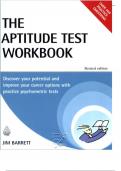Summary
Finance for Entrepreneurship and Business Innovation (E&BI) - FULL course summary - Entrepreneurship & business innovation - Tilburg University
- Course
- Institution
- Book
This summary covers all the content that is covered in the course: Finance for Entrepreneurship and Business Innovation (E&BI). This course is part of the Bachelor: Entrepreneurship and Business Innovation, at Tilburg University. Year 1, semester 1 COMPLETE SUMMARY
[Show more]













